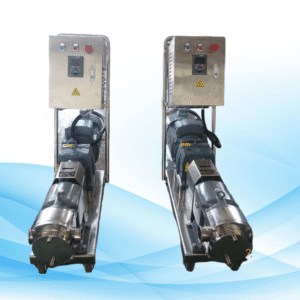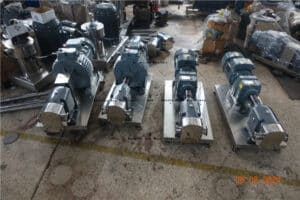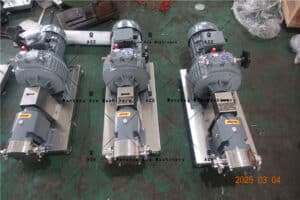Viscosity Handling, Pressure Response & Applications
Comparison between Centrifugal and Positive Displacement Pumps in Detail
| Features | centrifugal pumps | positive displacement pump |
|---|---|---|
| Efficiency | Peak efficiency at BEP, affected by viscosity | Maintains constant efficiency, handles high viscosity |
| Viscosity Handling | Excel with low viscosity, struggle with high viscosity | Struggles with low viscosity, excels with high viscosity |
| Pressure Response | Sensitive to pressure changes, struggles with stability | Handles pressure changes effectively, offers stability |
| Applications | Water supply, HVAC, irrigation | Metering, hydraulic systems, thick substances transfer |
Pumps are used in many industries including manufacturing and pharmaceuticals. There are two main types of pumps; centrifugal and positive displacement pumps. When choosing between the two, it is important to note that a centrifugal pump uses an impeller which spins around to create kinetic energy that increases the velocity of the fluid. Conversely, a positive displacement pump draws fluid into a cavity then forces it out through suction. The global industrial pumps market size was valued at around USD 70 billion in 2020 and is projected to reach USD 85-90 billion by 2025. This blog post will give you an in-depth comparison of these two types of pumps with their applications and unique features.
Reference Video
Definitions and Working Principles
Centrifugal Pumps

Definition: A mechanical device designed for moving fluids by converting rotational kinetic energy into hydrodynamic energy where they use a rotating impeller to increase the velocity of the fluid which later becomes pressure.
Working Principle: In this type of pump system; as shown above left diagram (1), when liquid enters through eye (2) due to electric motor driven high speed rotation imparts centrifugal force which pushes water outside through curved vanes thereby increasing its velocity before entering volute casing or diffuser section where high speed flow converts into higher pressure head resulting continuous discharge from outlet port (3).
Positive Displacement Pumps

Definition: Are mechanical devices that move fluids by trapping fixed volume then forcing it into discharge pipe i.e., Rotary or Reciprocating technology; Rotary uses meshing parts while reciprocating employs pistons plungers diaphragms etcetera.
Working Principle: Fluid is drawn into a cavity and mechanically displaced from there through the delivery side using certain means such as gears lobes etc., usually referred to as rotary pumps but when it comes to reciprocating ones they work by trapping certain quantity of liquid inside a chamber which gets pushed outwards with either piston or diaphragm thus ensuring almost uniform flow rate even if pressure changes. Positive displacement pumps can handle highly viscous fluids with ease and are also suitable for use under variable pressure conditions.
Efficiency Comparison
Centrifugal Pumps
Efficiency in Various Conditions: Centrifugal pump has an efficiency curve which peaks at its Best Efficiency Point (BEP). This point represents where the machine operates most effectively. Efficiency decreases greatly as you move away from BEP. High viscosity fluid affects this type of efficiency negatively because thicker liquids increase resistance hence preventing higher flows being maintained.
Factors Affecting Efficiency: There are several factors that affect how well centrifugal pumps work but impeller design is very key among them all since if not properly done then energy loss can occur during operation due to eddy current formation within passages leading into cavities where these devices are located; likewise smooth flow condition must be maintained throughout impellers’ periphery so that pump speed should be another consideration because high speeds accelerate wear tear which in turn reduces overall effectiveness over the long run depending on what properties of fluid one wants to know about- density too impacts performance directly since more power is needed move denser fluids while thicker ones offer resistance against flow
Positive Displacement Pumps
Efficiency under different conditions
Positive displacement pumps have efficiency that is almost constant across various conditions. These pumps can work with high viscosity fluids effectively which makes them suitable for use in applications that involve heavy substances like oils and resins. They do not deliver this consistent flow rate at all times unlike centrifugal pumps, positive displacement pump will always give the same amount of liquid despite any change in pressure. This property ensures unrivaled performance even if there are fluctuations in pressure.
Factors that affect efficiency
There are several things which determine how efficient a positive displacement pump is. The design of the chamber as well as precision with which its moving parts have been made play significant roles towards this end. Well engineered components help to minimize internal leakages hence ensuring proper fluid dislocation takes place within it. Efficiency may also be influenced by type of fluid being handled; these devices work best with liquids having high viscosities while they perform poorly when tasked against those with low ones. There also has to be regular servicing done so as to keep them running optimally whereby good lubrication should always accompany timely replacement of worn out parts.
Handling different fluid viscosities
Centrifugal Pumps
Performance with Low Viscosity Fluids
Centrifugal pumps come into their own where low viscosity fluids are concerned. This is due to impeller design that allows for easy movement without much resistance offered by such liquids towards it. When water or thin oils are pumped using this machine, it flows through the system smoothly because of less friction created by lightness in weight thus maintaining high efficiency throughout operation even if speed changes occur frequently along its path until at exit point where head needs most energy inputting into motion again before leaving funnel shaped inlet tube leading away from discharge outlet pipe connected somewhere between tanks full up capacity level achieved after some time elapsed since starting filling empty space left behind previously occupied tank. The impeller’s reduced friction drag ensures that optimum rate of flow is achieved at all times.
Performance with High Viscosity Fluids
The main problem with centrifugal pumps arises when they have to handle high viscosity fluids. At such times, the thickness of the fluid increases which in turn leads to a corresponding rise in friction drag acting against impellers’ rotation within it causing significant amount of energy loss thereby reducing pump efficiency considerably down so that desired flow rates and pressure heads cannot be sustained by them anymore as required for those types of liquids under those particular conditions where greater force needed moving through these machines against resistance offered by their heavy nature . This happens because more work has to done on them due increased resistance which is equivalent pumping syrup or thick oil through narrow pipe versus thinner one having same diameter but longer length filled up with water only Positive Displacement Pumps
Performance with Low Viscosity Fluids
Positive displacement pumps find it hard working with low viscosity fluids. Their construction entails trapping and pushing fixed volumes of liquid. The thinness of liquids like water makes them get past moving parts easily thus leading to inefficiency since consistent flow rate cannot be maintained by the pump. These devices work better when used for thick substances. Leakage is more pronounced in thinner fluids thus affecting overall performance.
Performance with High Viscosity Fluids
Positive displacement pumps are designed for use with highly viscous liquids. They can efficiently deal with this kind of materials by confining and displacing set amounts at any given time throughout their operation as shown below:High-viscosity substances such as oils or resins flow smoothly through positive displacement pump because they always have nearly equal speed irrespective changes made around it during pressure variations phase where other types may fail doing so especially if designed alone without backup system that will ensure continuous supply even when one unit fails during maintenance period Pressure Variations
Pressure Stability
Centrifugal pumps have problems in maintaining pressure stability. The speed at which the impeller rotates determines the pressure output. Any change in speed leads to corresponding changes in pressure. This lack of steadiness can cause problems for industries that need careful control over pressures during certain operations and processes. Thus, such industries often look for alternatives to centrifugal pumps when it comes to ensuring stable or constant pressures.
Positive Displacement Pumps
Response to Pressure Changes
Positive displacement pumps are good at responding to pressure changes. These machines maintain a nearly constant flow rate regardless of how much the pressure alters. What happens is that they always ensure that the trapped volume of fluid gets forced out uniformly. For this reason, positive displacement pumps work best where there are frequent fluctuations in pressure.
Pressure Stability
Positive displacement pumps guarantee better or higher levels of stability concerning pressures. It does this through mechanically trapping and displacing fluids thus giving a consistent output of pressured fluid.The viscosity and density of the liquid being pumped do not affect its performance.For this reason positive displace meant pump are preferred by many industries which require precise control over different types fluids under various conditions.
Typical Applications
Centrifugal Pumps
Common Uses
The wide range of applications served by centrifugal pumps is due to their ability to handle low-viscosity fluids efficiently. They are suitable for use in water supply systems because they can move large quantities of water without wasting energy. HVAC systems rely on these devices for circulating water and maintaining temperature settings within buildings.Irrigation systems also find them useful since they provide high flow rates necessary for even distribution over vast agricultural fields.
Industry Examples
Various sectors heavily depend on centrifugal pumps for day-to-day operations.Chemical plants use these machines extensively when transferring chemicals from one place another.In food processing factories where thin liquids like juices,milk etc need be transported,centrifugal force comes into play mostly.The oil and gas industry also relies on this equipment for moving petroleum products around as well as managing refineries.Municipalities have them installed at water treatment plants both supply wastewater management purposes.
Positive Displacement Pumps
Common Uses
Positive displacement pumps are used in situations where accurate flow control is required especially when dealing with highly viscous fluids.These type machines work great during metering/dosing applications because they can provide precise amounts of liquid consistently.Hydraulic systems use these kind of pumps to generate high pressures needed power various types machinery.Industries that deal with transfer thick substances such resins,oils,syrups etc prefer positive displacement pump due efficiency reliability exhibited by these devices when handling such materials.
Industry Examples
In pharmaceutical manufacturing companies,pumps play significant roles ensuring drugs active ingredients are administered correctly.Paints coatings factories would not be able operate smoothly without them since they help move around heavy liquids like paints,varnishes etc.Food processing plants need these units especially chocolate honey dough production lines.Cosmetics industries find it necessary having creams lotions gels manufactured using positive displacemnt pumps for consistent flow rates.
Think about the specific requirements and features of the application when choosing a pump. For high flow, low viscosity situations centrifugal pumps can be advantageous. Positive displacement pumps work best with high viscosity fluids and applications that require constant flow rates. Knowing these distinctions helps in making an appropriate choice of pumps which in turn increases efficiency and reliability during industrial operations.


















